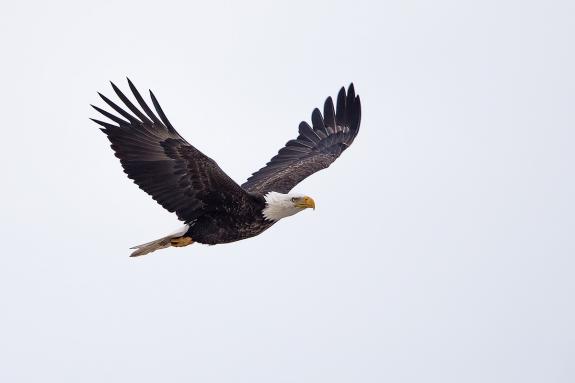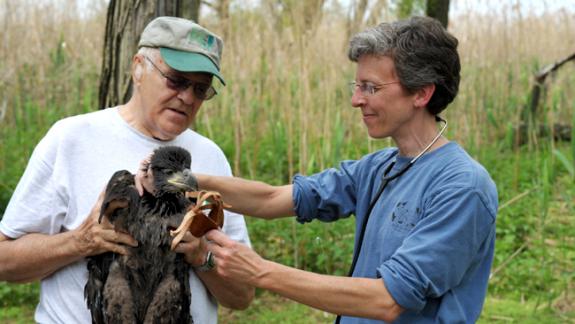New Jersey Endangered and Threatened Species Field Guide
 Zoom+ Bald eagles are the largest bird of prey in New Jersey. © Northside Jim
Zoom+ Bald eagles are the largest bird of prey in New Jersey. © Northside JimBald eagle
Haliaeetus leucocephalus
Species Group: Bird
Conservation Status
State: Endangered (Breeding)
Identification
Adult bald eagles are distinguished by their full white heads and tails and dark brown, almost black bodies. Adults also have yellow legs, bills, and eyes. Subadult and juvenile birds are brown overall with some white mottling. Juvenile birds reach their adult size by the time they can fly at approximately 12 weeks of age. White heads and tails do not appear until the birds are between four and five years of age. Both sexes have similar plumage, although the female is slightly larger than the male. With a wingspan of six to seven feet, eagles are larger than most birds. They are often confused with vultures and golden eagles from a distance.
 Zoom+ Range of the bald eagle in New Jersey.
Zoom+ Range of the bald eagle in New Jersey.
Distribution and Habitat
The bald eagle is restricted to North America and is usually found within close proximity to open water. In New Jersey, bald eagles reside year-round, usually remaining in the area surrounding their nest. The highest concentration of bald eagles occurs along the Delaware Bay in Salem and Cumberland counties but bald eagles are also found in central and northern New Jersey near lakes, reservoirs, and rivers. Bald eagles require a nesting location that is safe from the threat of human disturbance, and they choose a nesting tree accordingly. Bald eagles can move southward in the winter, far from the extreme northern part of its range. These nomadic birds may stopover in New Jersey.
Diet
Bald eagles eat mostly fish and other aquatic animals. They are extremely opportunistic though, and will eat almost anything that presents itself as a meal. They can also feed on waterfowl, muskrat, turtles, and carrion.
The highest concentration of bald eagles occurs along the Delaware Bay in Salem and Cumberland counties.
Life Cycle
Eagles usually build large stick nests close to water in some of the tallest trees in the forest. By nesting in a tall tree, they can place the nest within the shelter of the crown but still be above the surrounding trees, enabling them to arrive and depart from the nest with ease. Pairs frequently return to the same nest year after year. They begin courtship and nest building in late December and early January, adding to their existing nest. Over time, some nests can reach 10 feet across and weigh up to 2,000 pounds. Pairs lay one to three eggs in mid-February to early March, and incubate for about 35 days. Both males and females will share incubating responsibilities. Upon hatching, the chicks are helpless and require close parental care. After about five weeks, the young birds begin to stand up and feed themselves when the adults deliver food. Young birds fledge the nest at approximately 11 weeks of age, which is usually in early July. Adults will continue to feed young near the nest for several weeks while the young learn to fly and hunt. In late August many young eagles leave the area and may spend the following winter in the Chesapeake Bay area, where open water and abundant food provide favorable conditions.
 A bald eagle flies over the Holgate Unit of Edwin B. Forsythe NWR on Long Beach Island. © Northside Jim
A bald eagle flies over the Holgate Unit of Edwin B. Forsythe NWR on Long Beach Island. © Northside Jim
Current Threats, Status, and Conservation
New Jersey was once home to more than 20 pairs of nesting bald eagles. Unfortunately, as a result of the use of the pesticideDDT from the 1950s until the early 1970s, the number of nesting pairs of bald eagles in the state declined to only one by 1970. It remained at one into the early 1980s. Fortunately, the use of DDT was banned in the United States in 1972. In 1982, after the Bear Swamp eagle nest, New Jersey’s only active bald eagle nest since 1970, failed to produce young for at least six consecutive years, biologists removed eggs from the nest. The eggs were then incubated in the lab under chickens. Once hatched, the chicks were returned to the nest at 10 days old, and were quickly cared for by the adults. The reason for the failure of the nest and the necessity of this fostering technique was due to eggshell thinning as a result of DDT contamination. The eggs, if left in the nest for the adult eagles to incubate, would crack under the birds’ own weight. Fostering continued until 1989 when a new female nested and was able to hatch her own eggs.
Bald eagles are proven indicators of a healthy environment. Their presence tells us that the environment is clean and healthy.
Increasing the production from a single nest, however, was not enough to boost the state’s population in a reasonable amount of time. Mortality rates are as high as 80% in young eagles, and they do not reproduce until four or five years of age. State biologists instituted a hacking project in 1983 that resulted in the release of 60 young eagles (mostly from Canada) in New Jersey over an eight-year period. Because of these efforts, a second bald eagle nest was identified in 1988. These eagles have contributed to the increase in nesting pairs since 1990.
Biologists continually work to manage and reduce disturbance in eagle habitats, especially around nest sites. Eagles are very sensitive to human disturbance and will abandon their nest sites if people encroach on the area during the nesting season. Education and established viewing areas are important in minimizing disturbance. Volunteers are trained to monitor eagle nests throughout the state and provide vital information about nesting behaviors such as when adults return to the nest; when eggs are laid and hatch; and when the young eaglets fledge, or leave the nest for the first time.
 Elmer Clegg, an Eagle Project volunteer holds onto a Bald eagle nestling while Dr. Erica Miller places a hood on the bird to keep it calm while it is being banded for future identification. © Kathy Clark
Elmer Clegg, an Eagle Project volunteer holds onto a Bald eagle nestling while Dr. Erica Miller places a hood on the bird to keep it calm while it is being banded for future identification. © Kathy Clark
Bald eagles are proven indicators of a healthy environment. Their presence in the environment, tells us that the environment is clean and healthy. However, bald eagles as well as other raptors are still being impacted by chemicals and heavy metals in their environment. Continued monitoring during the nesting season helps to determine reproductive success and alerts us to any problems that may occur.
In 2007, the bald eagle was removed from the federal endangered species list. But here in New Jersey, the breeding population still has endangered species status, providing eagles the most protection. In 2018 there were 185 active bald eagle nests in New Jersey. Recovery efforts - implemented in the early 1980s - are now bearing fruit, as New Jersey’s eagle population rebounds from the edge of extinction.
Scientific Classification
Kingdom: Animalia
Phylum: Chordata
Class: Aves
Order: Accipitriformes
Family: Accipitridae
Genus: Haliaeetus
Species: H. leucocephalus
Find Related Info: Bald Eagles, Raptors, Endangered






